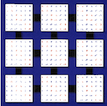1 SUBROUTINE pzlaqsy( UPLO, N, A, IA, JA, DESCA, SR, SC, SCOND,
12 DOUBLE PRECISION AMAX, SCOND
16 DOUBLE PRECISION SC( * ), SR( * )
157 INTEGER BLOCK_CYCLIC_2D, CSRC_, CTXT_, DLEN_, DTYPE_,
158 $ lld_, mb_, m_, nb_, n_, rsrc_
159 parameter( block_cyclic_2d = 1, dlen_ = 9, dtype_ = 1,
160 $ ctxt_ = 2, m_ = 3, n_ = 4, mb_ = 5, nb_ = 6,
161 $ rsrc_ = 7, csrc_ = 8, lld_ = 9 )
162 DOUBLE PRECISION ONE, THRESH
163 parameter( one = 1.0d+0, thresh = 0.1d+0 )
166 INTEGER IACOL, IAROW, ICTXT, II, IIA, IOFFA, IROFF, J,
167 $ jb, jj, jja, jn, kk, lda, ll, mycol, myrow, np,
169 DOUBLE PRECISION CJ, LARGE, SMALL
172 EXTERNAL blacs_gridinfo,
infog2l
176 INTEGER ICEIL, NUMROC
177 DOUBLE PRECISION PDLAMCH
178 EXTERNAL iceil, lsame, numroc, pdlamch
194 ictxt = desca( ctxt_ )
195 CALL blacs_gridinfo( ictxt, nprow, npcol, myrow, mycol )
196 CALL infog2l( ia, ja, desca, nprow, npcol, myrow, mycol, iia, jja,
202 small = pdlamch( ictxt,
'Safe minimum' ) /
203 $ pdlamch( ictxt,
'Precision' )
206 IF( scond.GE.thresh .AND. amax.GE.small .AND. amax.LE.large )
THEN
216 jn =
min( iceil( ja, desca( nb_ ) ) * desca( nb_ ), ja+n-1 )
221 IF( lsame( uplo,
'U' ) )
THEN
227 IF( mycol.EQ.iacol )
THEN
228 IF( myrow.EQ.iarow )
THEN
229 DO 20 ll = jj, jj + jb -1
231 DO 10 kk = iia, ii+ll-jj+1
232 a( ioffa + kk ) = cj*sr( kk )*a( ioffa + kk )
237 ioffa = ioffa + jb*lda
244 iarow = mod( iarow+1, nprow )
245 iacol = mod( iacol+1, npcol )
249 DO 70 j = jn+1, ja+n-1, desca( nb_ )
250 jb =
min( ja+n-j, desca( nb_ ) )
252 IF( mycol.EQ.iacol )
THEN
253 IF( myrow.EQ.iarow )
THEN
254 DO 40 ll = jj, jj + jb -1
256 DO 30 kk = iia, ii+ll-jj+1
257 a( ioffa + kk ) = cj*sr( kk )*a( ioffa + kk )
262 DO 60 ll = jj, jj + jb -1
265 a( ioffa + kk ) = cj*sr( kk )*a( ioffa + kk )
275 iarow = mod( iarow+1, nprow )
276 iacol = mod( iacol+1, npcol )
285 iroff = mod( ia-1, desca( mb_ ) )
286 np = numroc( n+iroff, desca( mb_ ), myrow, iarow, nprow )
291 IF( mycol.EQ.iacol )
THEN
292 IF( myrow.EQ.iarow )
THEN
293 DO 90 ll = jj, jj + jb -1
295 DO 80 kk = ii+ll-jj, iia+np-1
296 a( ioffa + kk ) = cj*sr( kk )*a( ioffa + kk )
301 DO 110 ll = jj, jj + jb -1
303 DO 100 kk = ii, iia+np-1
304 a( ioffa + kk ) = cj*sr( kk )*a( ioffa + kk )
314 iarow = mod( iarow+1, nprow )
315 iacol = mod( iacol+1, npcol )
319 DO 160 j = jn+1, ja+n-1, desca( nb_ )
320 jb =
min( ja+n-j, desca( nb_ ) )
322 IF( mycol.EQ.iacol )
THEN
323 IF( myrow.EQ.iarow )
THEN
324 DO 130 ll = jj, jj + jb -1
326 DO 120 kk = ii+ll-jj, iia+np-1
327 a( ioffa + kk ) = cj*sr( kk )*a( ioffa + kk )
332 DO 150 ll = jj, jj + jb -1
334 DO 140 kk = ii, iia+np-1
335 a( ioffa + kk ) = cj*sr( kk )*a( ioffa + kk )
345 iarow = mod( iarow+1, nprow )
346 iacol = mod( iacol+1, npcol )

